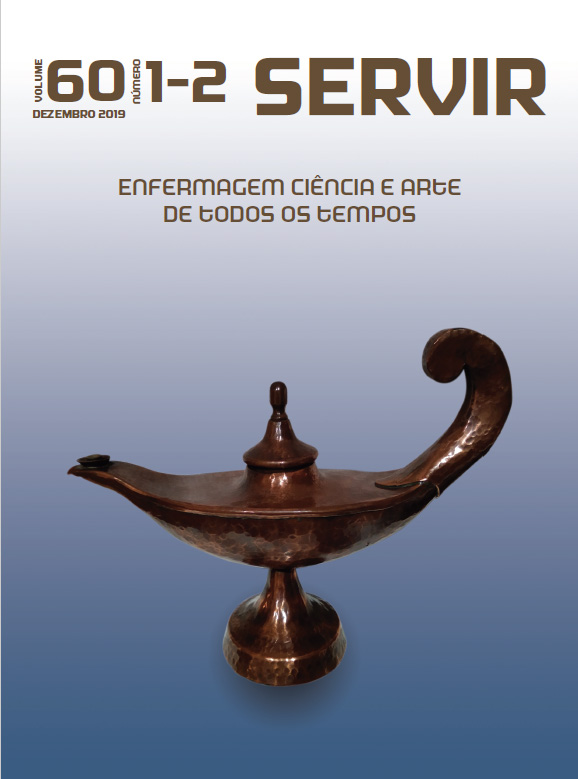Mouth care in the elderly
what controversies
DOI:
https://doi.org/10.48492/servir021-2.24495Keywords:
mouth care, elderly, nursing careAbstract
The quality of elderly’s mouth care is nurses’ responsibility. This study is an integrative literature review that aims to identify the current state of scientific knowledge about the controversies associated with the mouth care of the elderly. The bibliographic research occurred in June 2017 in national and international scientific databases, obtaining a final sample of five articles. The data resulted in the following thematic categories: Analysis of the concepts of mouth care in the elderly; Needs of the dependent elderly on the care of the mouth; Knowledge and skills of nurses in the provision of oral care in the elderly. It is assumed that nurses play a singular role in the context of the provision of mouth care in the elderly, but that it is an underestimated care, and there are innumerable gaps in the performance of these interventions.
Downloads
References
Osório, A., & Fernando, P. (2007). As pessoas idosas: contexto Social e Intervenção Educativa. Lisboa: Instituto Piaget.
Elliopoulos, C. (2005). Enfermagem Gerentológica (5a Edição). Porto Alegre: Artmed.
Collière, M.-F. (2003). Cuidar... a primeira arte da vida (2a Edição). Loures: Lusodidacta.
Chochinov, H. M. (2006). Dying , Dignity , and New Horizons in Palliative End-of-Life Care. A Cancer Journal for Clinicians, 56, 84–103.
OMS. (n.d.). Organização Mundial da saúde. Retrieved July 10, 2017, http://www.who.int/eportuguese/countries/prt/pt/
Heath, H., Sturdy, D., Edwards, T., Griffiths, J., Hylton, B., Jones, V., & Lewis, D. A. (2011). Promoting older people’s oral health.
WHO. (n.d.). World Health Organization. Retrieved July 10, 2001, http://www.who.int/en/
Sweeney, M. P., & Bagg, J. (2000). The mouth and palliative care. The American Journal of Hospice & Palliative Care, 17(2), 118–124. https://doi.org/10.1177/104990910001700212
Wohlschlaeger, A. (2004). Prevention and Treatment of Mucositis: A Guide for Nurses. Journal of Pediatric Oncology Nursing, 21, 281–287. https://doi.org/10.1177/1043454204265840
Davies, a N., Broadley, K., & Beighton, D. (2001). Xerostomia in patients with advanced cancer. Journal of Pain and Symptom Management, 22(4), 820–825.
Paulsson, G., Sciences, H., & Wårdh, I. (2008). Comparison of oral health assessments between nursing staff and patients on medical wards. https://doi.org/10.1111/j.1365-2354.2007.00802.x
Stout, M., Goulding, O., & Powell, A. (2009). Developing and implementing an oral care policy and assessment tool, (February 2004).
Rohr, Y., Adams, J., & Young, L. (2010). Oral discomfort in palliative care : results of an exploratory study of the experiences of terminally ill patients, 16(9), 439–444.
SECPAL. (n.d.). Guía de Cuidados Paliativos. Retrieved July 10, 2017, http://www.secpal.com/%5C%5CDocumentos%5CPaginas%5Cguiacp.pdf
Watson, J. (2002). Enfermagem - Ciência Humana e Cuidar uma teoria de Enfermagem. Camarate: Lusociência.
Adams, R. (1996). Qualified nurses lack adequate knowledge related to oral health, resulting in inadequate oral care of patients on medical wards. Journal of Advanced Nursing, 24(3), 552–560. https://doi.org/10.1046/j.1365-2648.1996.22416.x
Ribeiro, P. (2012). A Natureza Do Processo De Conforto Do Doente Idoso Crónico em Contexto Hospitalar.
Kolcaba, K. (2003). Comfort theory and pratice: a vision for holistic health care and research. (Springer Publishing Company, Ed.). New York.
Wårdh, I., Hallberg, L. R.-M., Berggren, U., Andersson, L., & Sörensen, S. (2000). Oral Health Care- A Low Priority in Nursing: In - depth Interviews with Nursing Staff. Scandinavian Journal of Caring Sciences, 14(2), 137–142. https://doi.org/10.1111/j.1471-6712.2000.tb00574.x
Southern, H. (2007). Oral care in cancer nursing : nurses ’ knowledge and education, (September 2006), 631–638. https://doi.org/10.1111/j.1365-2648.2006.04159.x
Harris, D. J., Eilers, J., Harriman, A., Cashavelly, B. J., & Maxwell, C. (2015). Putting Evidence Into Practice ® : Evidence - Based Interventions for the Management of Oral Mucositis, 12(1), 141–152.
Wilkin, K., & Wilkin, K. (2002). A critical analysis of the philosophy , knowledge and theory underpinning mouth care practice for the intensive care unit patient, 3397(2), 181–188. https://doi.org/10.1016/S0964-3397(02)00017-4
Gibson, F., Horsford, J., & Nelson, W. (1997). Oral care: ritualistic practice reconsidered within a framework of action research. Journal of Cancer Nursing, 1(4), 183–190. https://doi.org/10.1016/S1364-9825(97)80517-2
Honnor, A., & Law, A. (2002). Mouth care in cancer nursing: using an audit to change practice. Br J Nurs, 11(16), 1087–1096. https://doi.org/10.12968/bjon.2002.11.16.10550
Cohn, J. L., & Fulton, J. S. (2006). Nursing staff perspectives on oral care for neuroscience patients. The Journal of Neuroscience Nursing : Journal of the American Association of Neuroscience Nurses, 38(1), 22–30. http://www.ncbi.nlm.nih.gov/pubmed/16568810
Hesbeen, W. (2001). Qualidade em Enfermagem. pensamento e acção na perspectiva do Cuidar. Lusociência.
Souza, M. T. de, Silva, M. D. da, & Carvalho, R. de. (2010). Revisão integrativa: o que é e como fazer. Einstein, 8(1), 102–106. https://doi.org/10.1590/S0104-07072008000400018
Fitzpatrick, J. (2000). Oral health care needs of dependent older people : responsibilities of nurses and care staff, 32(6), 1325–1332.
Ferreira, R., Rocha, E., Coutinho, N., Ribeiro, M., Magalhães, C., & Moreira,
A. (2006). La actuación del equipo de enfermería en la higiene bucal de los ancianos dependientes hospitalizados. Investigación Y Educación En Enfermería, XXIV, 48–57.
Costello, T., & Coyne, I. (2008). Nurses ’ knowledge of mouth care practices, 17(4), 264–268.
Bissett, S., & Preshaw, P. (2011). Guide to Providing Mouth Care for Older People. Nursing Older People, 23(10), 14–21.
Coker, E., Ploeg, J., Kaasalainen, S., & Fisher, A. (2013). A concept analysis of oral hygiene care in dependent older adults. https://doi.org/10.1111/jan.12107
Downloads
Published
How to Cite
Issue
Section
License
In order to promote the free circulation of knowledge, Servir is open access journal. All its content is available and protected under the Creative Commons license (CC BY 4.0).
The journal allows self-archiving in institutional repositories of all versions, which may become immediately available


